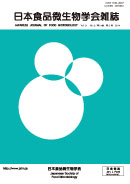Volume 31, Issue 3
Displaying 1-9 of 9 articles from this issue
- |<
- <
- 1
- >
- >|
Review
-
Article type: Review
2014Volume 31Issue 3 Pages 129-137
Published: September 30, 2014
Released on J-STAGE: January 27, 2015
Download PDF (886K)
Symposium II: Recent Advances of Research in Food Poisoning Microorganisms—Emphasizing Ecological Aspects
-
Article type: Symposium II
2014Volume 31Issue 3 Pages 138
Published: September 30, 2014
Released on J-STAGE: January 27, 2015
Download PDF (190K) -
Article type: Symposium II
2014Volume 31Issue 3 Pages 139-143
Published: September 30, 2014
Released on J-STAGE: January 27, 2015
Download PDF (392K) -
Article type: Symposium II
2014Volume 31Issue 3 Pages 144-147
Published: September 30, 2014
Released on J-STAGE: January 27, 2015
Download PDF (618K) -
Article type: Symposium II
2014Volume 31Issue 3 Pages 148-152
Published: September 30, 2014
Released on J-STAGE: January 27, 2015
Download PDF (1995K) -
Article type: Symposium II
2014Volume 31Issue 3 Pages 153-159
Published: September 30, 2014
Released on J-STAGE: January 27, 2015
Download PDF (651K)
Original
-
Duration of Sapovirus RNA Excretion in Infected Food Handlers and Genetic Analysis of Detected VirusArticle type: Original
2014Volume 31Issue 3 Pages 160-166
Published: September 30, 2014
Released on J-STAGE: January 27, 2015
Download PDF (602K)
Short Paper
-
Article type: Short Paper
2014Volume 31Issue 3 Pages 167-170
Published: September 30, 2014
Released on J-STAGE: January 27, 2015
Download PDF (417K)
Epidemiology
-
Article type: Epidemiology
2014Volume 31Issue 3 Pages 171-175
Published: September 30, 2014
Released on J-STAGE: January 27, 2015
Download PDF (252K)
- |<
- <
- 1
- >
- >|
